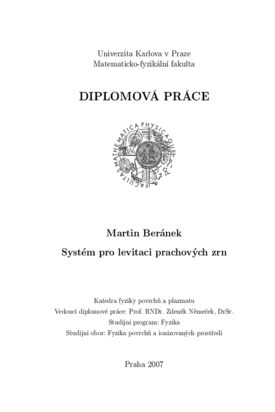Systém pro levitaci prachových zrn
System for Dust Grain Levitation
diploma thesis (DEFENDED)

View/Open
Permanent link
http://hdl.handle.net/20.500.11956/9290Identifiers
Study Information System: 43261
Collections
- Kvalifikační práce [11325]
Author
Advisor
Referee
Čermák, Ivo
Faculty / Institute
Faculty of Mathematics and Physics
Discipline
Physics of surfaces and ionized media
Department
Department of Surface and Plasma Science
Date of defense
18. 5. 2007
Publisher
Univerzita Karlova, Matematicko-fyzikální fakultaLanguage
Czech
Grade
Excellent
Laboratorní simulace nabíjení prachových zrn mohou poskytnout informace o samostatném působení různých nabíjecích procesů, které od sebe jinak nelze oddělit. Znalost působení jednotlivých vlivů je důležitá pro pochopení nabíjení prachových zrn v reálných podmínkách. Pro měření v laboratoři se používá elektrodynamická past, ve které je zachyceno jediné prachové zrno. V práci jsou analyzovány některé geometrie elektrodynamické pasti a jejich vliv na přesnost měření. Důraz je kladen na nalezení takového rozložení elektrod, které vytvoří hodně otevřenou past, a tím minimalizuje nežádoucí emisi elektronů z elektrod. Byla nalezena úprava lineárního kvadrupólu, která umožňuje udržení nabitého zrna i ve směru osy pasti a z provedených výpočtů plyne, že úprava by neměla negativně ovlivnit vlastnosti elektrického pole s ohledem na určení měrného náboje zrna.
Laboratory simulations of dust grain charging can provide an unique data about inuence of the separate charging processes, which are inseparable otherwise. Knowledge of the inuence of individual processes is important for understanding charging dust grains in real conditions. For laboratory experiments the electrodynamic trap, in which is captured single dust grain, is used. We have analysed several particular trap geometries and their inuence on the accuracy of measurements in this work. We deale mainly with nding of the electrode layout, which forms an open trap and therefore minimises unwanted electron emission from electrodes. We have found such modication of a linear quadrupole, which allows to trap the charged grain in the axial direction too. The calculation shows that the modication should not have a negative inuence on the electric eld with respect to the measuring of the grain specic charge.
